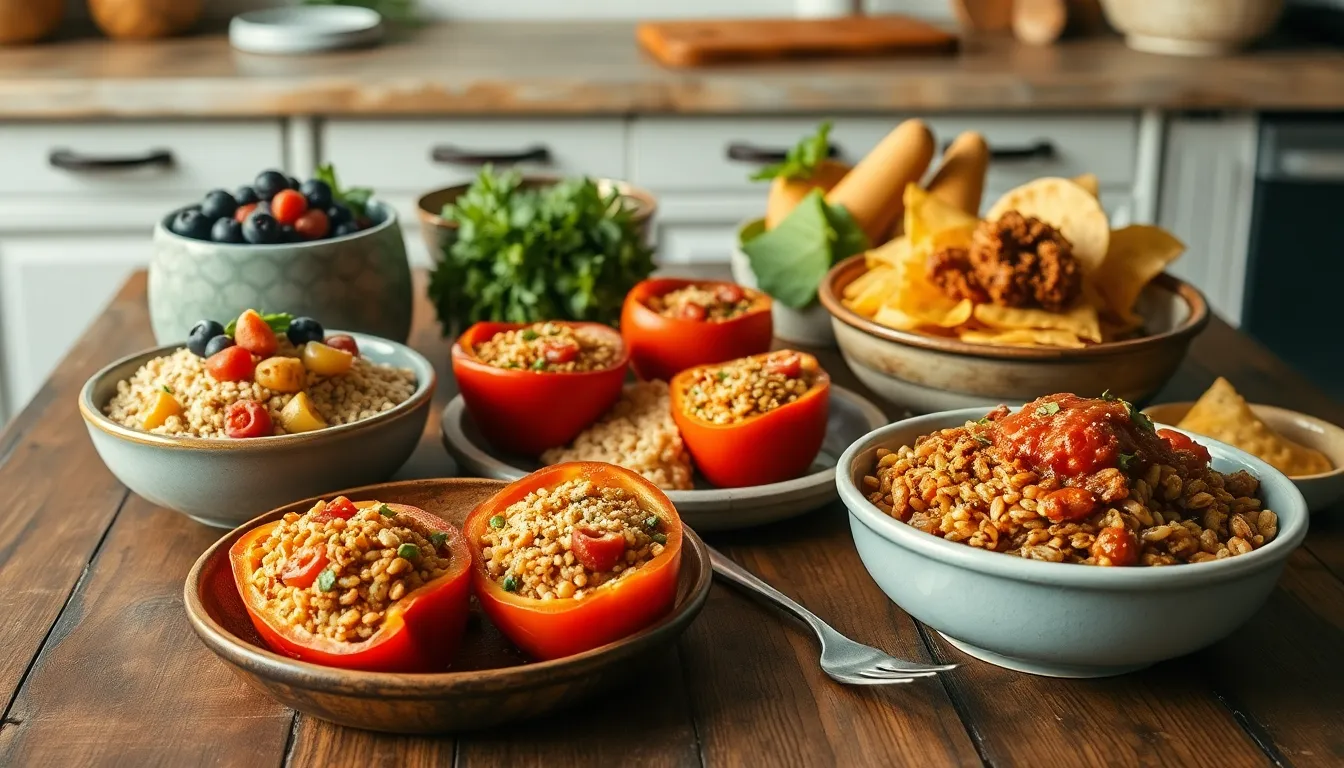In a world where fast food reigns supreme and kale is often the punchline of a joke, whole grain meals stand out as the unsung heroes of nutrition. These wholesome wonders pack a punch of flavor and health benefits, making them the secret weapon for anyone looking to elevate their dining game. Who knew that something so good for you could also be so delicious?
Table of Contents
ToggleBenefits Of Whole Grain Meals
Whole grain meals offer significant advantages that enhance overall well-being. Nutritionally dense, these meals provide essential vitamins and minerals.
Nutritional Value
Whole grains contain a rich supply of fiber, protein, and important nutrients such as B vitamins and iron. Fiber contributes to digestive health, promoting regularity and aiding weight management. Additionally, whole grains deliver antioxidants that combat oxidative stress in the body. Eating a variety of whole grains, like brown rice, quinoa, and oats, boosts nutrient intake, leading to a more balanced diet.
Health Advantages
Whole grain consumption correlates with reduced risk of chronic diseases. Eating whole grains can lower the likelihood of heart disease, type 2 diabetes, and certain cancers. Regular intake positively affects cholesterol levels and supports heart health. Studies indicate that individuals who consume whole grains experience better glycemic control, improving insulin sensitivity. Incorporating whole grain meals into daily diets enhances overall health and promotes longevity.
Types Of Whole Grain Meals

Whole grain meals present diverse options for all times of the day. They combine nutrition with flavor, enhancing meals significantly.
Breakfast Options
Oatmeal serves as a nutritious breakfast option, offering fiber and protein to start the day. Whole grain pancakes, made with whole wheat flour, provide a fluffy, satisfying alternative. Quinoa porridge, rich in essential amino acids, works well topped with fruits and nuts. Whole grain toast pairs nicely with avocado or nut butter, creating a balanced and filling meal. Smoothies can include whole grain elements like rolled oats, making them both refreshing and substantial.
Lunch Ideas
Whole grain salads can incorporate farro or barley, adding texture and nutrients to vegetables. Wraps made with whole grain tortillas provide a convenient way to combine proteins, snacks, and greens. Quinoa bowls, featuring seasonal vegetables and a protein source, create hearty, well-rounded meals. Brown rice stir-fries encourage a variety of flavors and ingredients, enhancing the overall lunch experience. Soups thickened with whole grains like bulgur add nutrition while being comforting and satisfying.
Dinner Possibilities
Whole grain pasta creates an excellent base for a variety of sauces and vegetables, improving nutrient density. Stuffed peppers filled with brown rice and beans offer a colorful, nutritious option that’s both filling and flavorful. Millet risotto presents a creamy texture, pairing well with seasonal produce. Whole grain pizza crusts allow for creative toppings while maintaining a healthy focus. Grain bowls, featuring a blend of grains, proteins, and fresh greens, serve as a complete meal that supports overall health.
How To Incorporate Whole Grains In Your Diet
Incorporating whole grains into daily meals boosts health and enhances flavor. Exploring practical strategies can simplify this process.
Meal Planning Tips
Plan meals around whole grain ingredients for better nutrition. Start the week by preparing a grocery list that includes whole grain options like oatmeal, quinoa, and brown rice. Consider cooking batch portions of grains, making it easier to add them to various meals. Incorporate leftovers into lunches with whole grain wraps or salads, maximizing their usage. Experiment with breakfast options by including whole grain pancakes or overnight oats to diversify the morning routine. Choose recipes that highlight grains for dinner, such as stuffed peppers or grain bowls. Visualize a balanced plate, ensuring whole grains take center stage alongside vegetables and proteins.
Cooking Techniques
Opt for cooking methods that preserve whole grain nutrients while enhancing flavor. Steam or sauté vegetables to pair with grains for a more vibrant dish. Use baking techniques for items like whole grain pizza crusts or muffins, which can be both healthy and enjoyable. Try slow cooking grains, allowing flavors to meld together in dishes like hearty risottos. Boiling is a quick method for grains like quinoa and brown rice, creating a nutritious base for meals. Experimenting with seasoning can elevate whole grains, adding spices or herbs to enhance taste. Incorporate whole grains gradually into recipes, replacing refined versions to smooth the transition to healthier options.
Common Misconceptions About Whole Grains
Whole grains often face misunderstandings that can cloud their benefits. Clearing up these misconceptions is essential for informed choices.
Myths Debunked
Many believe whole grains lack taste compared to refined grains. In reality, whole grains offer diverse flavors and satisfying textures. Some think all whole grain products are equally healthy, but not all claim quality. It’s crucial to check for whole grains listed first in ingredient lists. Individuals often assume whole grains cause digestive issues. However, for most people, whole grains support digestive health due to their high fiber content. Overall, awareness of these myths enhances appreciation for whole grains.
Understanding Whole Grains
Whole grains encompass all three parts of the grain: bran, germ, and endosperm. This structure retains essential nutrients like fiber, B vitamins, and iron. Whole wheat, brown rice, quinoa, and oats represent popular whole grains available. People may confuse whole grain with the term “multigrain,” which doesn’t guarantee health benefits. Examining packaging can help determine if a product is truly whole grain. Incorporating these grains into meals can enhance nutritional value while promoting overall well-being.
Embracing whole grain meals can transform both health and dining experiences. These nutrient-rich options provide essential vitamins and minerals while delivering satisfying flavors. By replacing refined grains with whole grains, individuals can enjoy a variety of delicious meals that support overall well-being.
With practical strategies for incorporating these grains into daily diets, anyone can make the switch easily. Whole grains not only enhance meals but also contribute to long-term health benefits, reducing the risk of chronic diseases.
Choosing whole grains is a simple yet impactful way to nourish the body and elevate culinary enjoyment.



